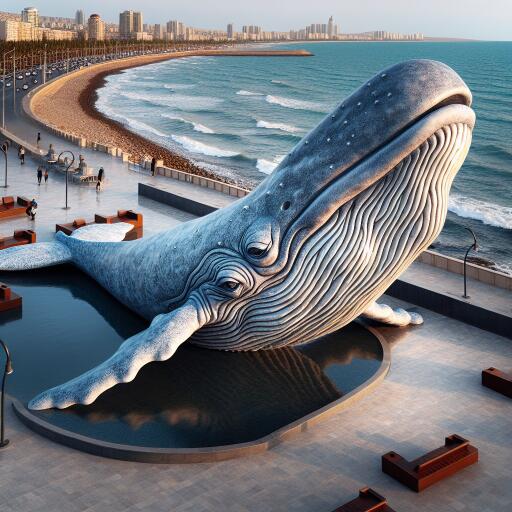
A Sperm Whale on the Baku Boulevard Reminds Us of the Problems Facing Caspian Fauna
On a brisk Monday morning, Baku Boulevard became the stage for an unexpected sight: a baby sperm whale seemed to have found its way to the bustling promenade. Passersby stopped in their tracks, puzzled and intrigued by this unusual visitor, only to later realize that it was not a live whale but an artistic installation aimed at raising environmental awareness. The display, organized in conjunction with COP29, brought much-needed attention to critical ecological issues affecting our seas and oceans.
Despite the fact that sperm whales no longer populate the Caspian Sea, their ancient ancestors once inhabited these waters approximately 25 million years ago. During the Oligocene and Miocene epochs, whales similar to sperm whales evolved and roamed the region’s primordial oceans. Fossils discovered in Azerbaijan in the 1970s provide evidence of this prehistoric presence. While nature’s course has led to the disappearance of sperm whales in the Caspian, the current marine life in the region is under significant threat and demands our focus.
The Caspian Sea, the world’s largest enclosed body of water, is experiencing declining wildlife populations due to various factors, particularly rapidly decreasing water levels. At the dawn of the 20th century, up to a million Caspian seals thrived; however, by 1989, their numbers plummeted to 400,000 and continued to dwindle over the decades. Fast forward to 2019, and the population was struggling between 43,000 and 66,000.
Recent surveys have uncovered a disheartening number of dead seals along the Caspian’s shores. In the Mangystau region of Kazakhstan alone, over 400 deceased animals were found during a brief period of shoreline monitoring. Kazakhstan and the North Caucasus consistently report similar finds, with 2020 marking one of the worst seal mortality incidents: thousands washed ashore on the beaches of Azerbaijan and Kazakhstan.
The cause of this alarming die-off has primarily been linked to the canine distemper virus, although pollution has played a contributory role. Water quality tests conducted near Russia and Azerbaijan revealed elevated concentrations of harmful chemicals. Such contamination weakens the seals’ immune defenses, making them susceptible to viral outbreaks and further reducing their already dwindling numbers. This prompted the inclusion of the Caspian seal in the Red Book in Kazakhstan and Russia in 2020.
The recent discovery of 17 dead seals in Azerbaijan’s Khachmaz region in December 2022 underscores the severity of the situation. Analyses suggested the carcasses had drifted from Russian waters, echoing past mass die-offs in Dagestan, where natural gas emissions were found to have intersected with seal migration routes. Such gas emissions, particularly during seal migration seasons, are believed to cause massive mortality events.
Human actions also play a crucial role in the crisis facing marine creatures. Conservationists on Sakhalin have made efforts to rescue northern fur seals from the grip of plastic detritus, demonstrating the tangible threat of waste pollution on marine life.
Notably, the Caspian seal is an endemic species, the sole mammal in the Caspian Sea. It sustains itself predominantly on a diet of fish, mollusks, and shrimp, adapting to seasonal movements. In winter, these seals migrate to the colder northern parts of the sea, relocating to the more temperate southern waters in warmer months.
Returning to the sperm whale installation, it’s crucial to highlight that large marine animals such as whales and sharks cannot survive in the Caspian today, as this landlocked sea lacks the depth and vastness these creatures require. Their ancient presence was possible during eras when a proto-ocean spilled across what is now landlocked territory.
Our contemporary mission should center on safeguarding the vivid life forms that still flourish in our ecosystems. While whales no longer swim in the Caspian, it is our duty to ensure that the creatures that call this unique sea home continue to inhabit and enrich our environment.
Nature’s resilience and the challenges it faces should remind us of the active steps required to preserve and protect the natural world — a responsibility that is underscored by installations like the sperm whale on Baku Boulevard.





Leave a Reply